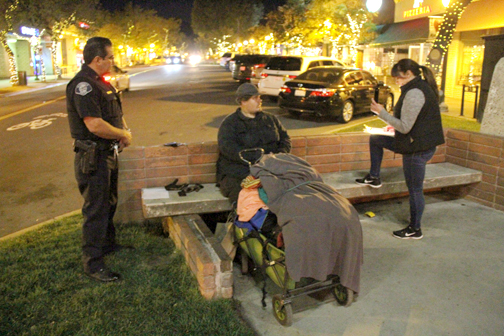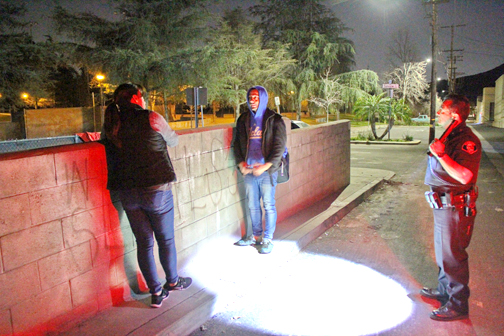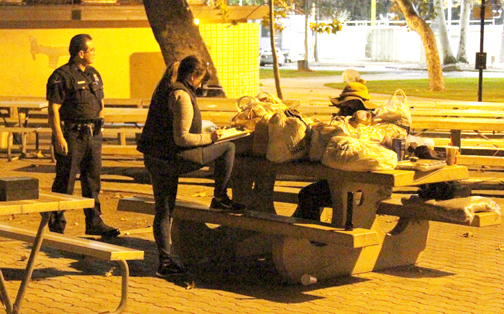
Lt. Rodriguez, left, and Chris Zastrow, right, conduct the survey with David Bohdan, a homeless citizen who frequents the Montrose Shopping Park.
By Charly SHELTON
The homeless population in Glendale fluctuates quite a bit. In 2010, there were 428 individuals counted. In 2017, there were 168 individuals, a 10-year low. The number of individuals and the severity of their needs are taken into account when cities apply for federal funding for homeless assistance through the Dept. of Housing and Urban Development. But this requires an accurate survey of the homeless population. So once a year, in January, teams of volunteers from the City of Glendale Community Services and Parks Dept., Glendale Police Dept. and the community at-large gather to conduct a needs assessment. They venture out into the streets to meet the homeless citizens of Glendale and ask what kind of help would benefit them the most.
“I volunteered to become a little more aware of the situation with the homeless to understand it a little more clearly because I am concerned, myself, as a Glendale resident, about their impact and getting them help and keeping the problem [of homelessness] under control,” said Chris Zastrow, a realtor with Dilbeck.

The survey was conducted by five teams that spread across the city from south Glendale all the way to La Crescenta and Montrose. Each team was given a map with known locations of homeless citizens who frequent the same parks or alleys each night. Members of the team, led by GPD officers, asked the individuals for their permission before filling out the survey.
“I knew that we were getting more homeless people, particularly up in La Crescenta and Montrose, which is where I concentrated this year,” said Lt. Oscar Rodriguez, lieutenant in charge of the Community Impact Bureau of the GPD. “Every corner of every community is affected by the problem of homelessness. It doesn’t matter if you’re an affluent or underprivileged community; homelessness affects almost every community in our society. And that’s what we’re seeing up here in La Crescenta and Montrose.”

Lt. Rodriguez, who recently completed his master’s thesis on the homeless issues in Glendale, is familiar with many of the homeless citizens of La Crescenta and Montrose from his work with the CIB. Many of the homeless population in the Crescenta Valley and Glendale, he said, are in those areas because they are safer areas and homeless people are as afraid of bad areas of town as anyone. Being on the street all the time leads to more instances of violence against them, and they gravitate toward safe places because the likelihood of violence is reduced.
While the survey information is confidential, some of the homeless citizens interviewed did give CV Weekly permission to photograph them and share their stories. Some lost their homes in the recent fires and have nowhere else to go. Some are fleeing domestic abuse. Some were homeless on the east coast and came out to California looking for a better climate in which to live outside and hopefully find some work. There are hundreds of stories just like these that lead to homelessness, and there is no easy solution. Through local charities and the HUD funding, the City of Glendale hopes to help these homeless citizens move into interim and/or permanent housing.
The City receives roughly $2.4 million per year in federal funds for homeless aid thanks to the annual survey done in January. This money is divided among a City of Glendale program, individual caseworkers and local charities that help the homeless find housing, get jobs, get medical treatment and more. Of the roughly 2,400 people who are in a program and are in various stages of homelessness, about 90% exit to permanent housing and, of that 90%, about 70% stay in the arranged housing. It is a never-ending battle for those who work to help the homeless, but when they see someone turn his or her life around, it’s all worth it.
“I have been working with homeless services since 1993 and, honestly, I have my ups and downs on a daily basis,” said Ivet Samvelyan, Community Services manager with the City of Glendale. “[What keeps me going], most importantly, is seeing people change their lives, seeing people we counted last year and, a couple of months later, they’re in housing.”
